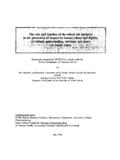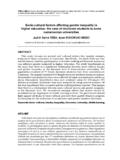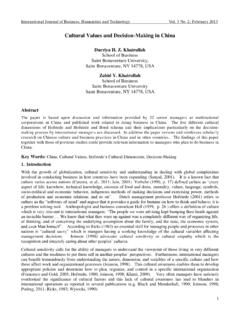Transcription of The cultural models in international business …
1 The cultural models in international business research: A bibliometric study of IB journals Nuno Rosa Reis Instituto Polit cnico de Leiria Manuel Portugal Ferreira Instituto Polit cnico de Leiria Jo o Carvalho Santos Instituto Polit cnico de Leiria 2011. Working paper n 76/2011. globADVANTAGE. Center of Research in international business & Strategy INDEA - Campus 5. Rua das Olhalvas Instituto Polit cnico de Leiria 2414 - 016 Leiria PORTUGAL. Tel. (+351) 244 845 051. Fax. (+351) 244 845 059. E-mail: Webpage: WORKING PAPER N 76/2011. Junho 2011. Com o apoio 2. The cultural models in international business research: A. bibliometric study of IB journals Nuno Rosa Reis School of Technology and Management globADVANTAGE Center of Research in international business & Strategy Polytechnic Institute of Leiria, Portugal Morro do Lena - Alto Vieiro 2411-901 Leiria, PORTUGAL.
2 E-mail: Manuel Portugal Ferreira School of Technology and Management globADVANTAGE Center of Research in international business & Strategy Polytechnic Institute of Leiria, Portugal Morro do Lena - Alto Vieiro 2411-901 Leiria, PORTUGAL. E-mail: Jo o Carvalho Santos School of Technology and Management globADVANTAGE Center of Research in international business & Strategy Polytechnic Institute of Leiria, Portugal Morro do Lena - Alto Vieiro 2411-901 Leiria, PORTUGAL. E-mail: Acknowledgements We are thankful for the valuable research assistance of Dora Ferreira. 3. The cultural models in international business research: A bibliometric study of IB journals ABSTRACT. Culture has been a widely researched topic in the international business (IB) literature over the last decades. To better understand what culture actually means and its implication in firms' IB operations, several cultural models and taxonomies have been put forward.
3 In this paper we seek to scrutinize the use of three well known cultural models - Hall's (1976), Hofstede's (1980a) and Trompenaars & Hampden-Turner's (1993) - in the extant research. Using bibliometric techniques of the papers published in the top ranked IB journals, we performed a citation and co-citation analysis to find out the most influential model and to examine the possible linkages between models and to the issues being researched. We conclude that Hofstede's (1980a) taxonomy is the most cited and his taxonomy has strong linkages to several streams of research. Nonetheless, we also find that there are noticeable differences on how research in different journals make use of the cultural models , probably reflecting not surprising disciplinary emphases. KEYWORDS: cultural models , Hofstede, Trompenaars, Hall, bibliometric study.
4 4. INTRODUCTION. Culture has long been capturing scholars' attention. Over the last decades, management scholars have delved into cultural and cross- cultural issues especially in the IB field. The impact of culture in the IB literature is recurrently focused upon, namely seeking to explain the impact of national and regional culture, and cultural variations, in management ( , Nes, Solberg & Silkoset, 2007; Ralston et al., 2008; Zutshi & Tan, 2009) and, more widely, on a variety of decisions regarding the choice of location and foreign entry modes deployed. The manner in which firms respond to cultural differences may help explain why firms differ and why there are performance differences between firms (Hawawini, Subramanian & Verdin, 2003; Mackey, Mackey & Barney, 2007; Sirmon, Hitt & Ireland, 2007).
5 Understanding the influence of culture in business practices and managerial decision making requires explaining the differences between cultures. Several models and classifications of culture have emerged to provide a comparable frame of reference. For instance, Hall (1976). developed a taxonomy establishing high and low context cultures, which takes into account the importance of context in decoding the communication and more broadly a set of aspects related to the interaction among individuals. Hofstede (1980a) presented a much cited cultural model comprising four main dimensions of culture: individualism-collectivism, uncertainty avoidance, power distance and masculinity-femininity, later added of one additional dimension the confucian dynamism (Hofstede &Bond, 1988). Trompenaars and Hampden-Turner (1993) proposed a classification comprising seven cultural dimensions that characterizes a culture and may be used to distinguish one national culture from another.
6 More recently, the GLOBE project presented a more extensive cultural model comprising nine dimensions (see House et al. (2004) for a description). These cultural frameworks are utilized to encompass the cultural variations that may bear a significant impact on the internationalization of firms, the manner in which firms are organized, the human resource management practices, and so forth. That is, they provide us with a comparable starting point for IB studies, focusing on a specific environmental dimension: culture. 5. Our starting point for this research was determining which of the cultural models available for analysis is most used in international business (IB) research and how they are used. All the cultural models have received some degree of criticism. High and low context cultures (Hall, 1976) are pointed at for not being submitted to peer review and for being insufficiently confirmed by empirical works (Cardon, 2008).
7 Hofstede's four dimensions were considered overly simplistic, ignorant of the cultural differences within a country and for having a limited sample (Kirkman, Lowe & Gibson, 2006). The seven dimension model (Trompenaars & Hampden-Turner, 1993) was criticized for not being supported by Hofstede's database and therefore not valid (Hofstede, 1996). Since no single model has received unanimity, we seek to understand which model is used the most in IB literature. In this article we analyze the relevance of cultural models and we scrutinize its use in the extant IB research. Empirically, we use bibliometric techniques to ascertain the most influential model in the articles published in the top ten ranked IB journals (DuBois & Reeb, 2000): Journal of international business Studies (JIBS), Management international Review (MIR), Journal of World business (JWB), international Marketing Review (IMR), international business Review (IBR), Journal of international Marketing (JIM), international Studies of Management and Organization (ISMO), Advances in international Marketing (AIM), Advances in international Comparative Management (AICM), international Journal of Research in Marketing (IJRM), Journal of Global Marketing (JGM) and Multinational business Review (MBR).
8 We seek to understand the intellectual structure of the extant IB research, by analyzing the citations and co-citations. The article proceeds as follows. First, we briefly review the cultural models considered in this study. Second, we present the bibliometric method used, sample and key results. We conclude with a broad discussion and advancing some suggestions for future scholarly investigation. LITERATURE REVIEW. The international business environment is the distinguishing factor between IB research and other management fields (Guisinger, 2000; 2001;. Ferreira et al., 2009). Understanding the international business environment 6. in which firms operate, involves understanding that every organization exists in a specific physical, technological, cultural and social environment to which it must adapt (Scott , 2002: p.)
9 21). One of the arguably primary building block of the international environment is culture. In fact, culture is a common element in several frameworks and taxonomies. For instance, Ghemawat (2001) identified the CAGE framework, composed of Culture, Administration, Geography and Economy. Guisinger (2000, 2001) identified the ECLIPTER, comprising eight environmental dimensions: Econography, Culture, Legal system, Income level, Political risk, Tax regime, Exchange rate, and context, namely the cultural context, seems to be crucial in IB research. Culture plays a major role in characterizing the environmental context in which firms operate and decide, chose strategies and structures. For instance, culture was shown by Lachman and colleagues (1994) to shape the organizational structures of firms, Shane (1993) related culture to entrepreneurial activity, Graham et al.
10 (1994) noted that negotiation behaviors shifted with national culture. Without generalizability across space, we are dealt a set of domestic, uni-national, and narrow scope theories. Krathwolhl (1985, p. 74) put it better when he asked a fundamental question for external validity of models , constructs and theories: "[w]ould this relationship replicate with people or other cultures, in other countries of the world?". Culture and cultural models Albeit there is no unanimous definition for culture, we may find a set of common components of what culture entails, ranging from a subjective perception' (Triandis, 1972), a subconscious mechanism' (Hall, 1983), to an acquired behavior' (Kroeber & Kluckhohn, 1952), or learned attitudes'. (Spencer-Oatey, 2000). Hofstede (1980a: p. 25), for instance, defines culture as [t]he collective programming of the mind which distinguishes the members of one human group from another, the interactive aggregate of common characteristics that influence a human group's response to its environment.




